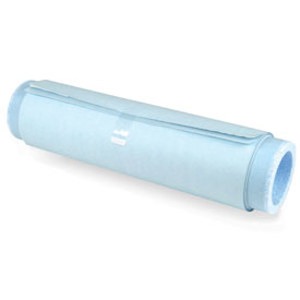PALL BioTrace™ NT Nitrocellulose Transfer Membrane (30cm x 3m roll)
Catalog No :
CAS Number :
Brand :
In Stock
Specifications:
| Application | Protein Electrophoresis & Western Blotting |
| Storage Temperature | Room Temperature |
| Product Type | Filter Papers |
| Product Brand | PALL |
| Product Grade | Molecular Biology |
The PALL BioTrace™ NT Nitrocellulose Transfer Membrane is a high-quality membrane specifically designed for the efficient transfer and immobilization of biomolecules such as proteins, nucleic acids, and peptides. This membrane is widely used in Western blotting, Southern blotting, and Northern blotting techniques, providing superior sensitivity and binding performance.
Key Features
- High Protein and Nucleic Acid Binding Capacity:
- The membrane ensures efficient immobilization of biomolecules for downstream detection.
- Provides a strong and stable signal for sensitive and reproducible results.
- Uniform Pore Structure:
- Offers consistent pore size distribution for uniform transfer efficiency.
- Ideal for even and consistent immobilization across the membrane surface.
- High Signal-to-Noise Ratio:
- Minimizes background signals, improving assay sensitivity.
- Delivers clear and reliable detection of low-abundance targets.
- Compatibility:
- Compatible with commonly used blotting techniques (Western, Southern, and Northern blots).
- Suitable for a wide range of detection methods, including chemiluminescence, fluorescence, and radioactive labeling.
- Large Format Roll:
- The 30 cm x 3 m roll provides flexibility for custom sizing, making it cost-effective for labs with varying blotting needs.
- Durability:
- Nitrocellulose membranes are inherently durable, with excellent mechanical strength for easy handling.
Specifications
| Property | Details |
|---|---|
| Material | Nitrocellulose |
| Pore Size | Optimized for biomolecule transfer |
| Dimensions | 30 cm x 3 m roll |
| Format | Roll (customizable sizing) |
| Compatibility | Western blotting, Southern blotting, Northern blotting |
| Detection Methods | Chemiluminescence, fluorescence, radioactive labeling |
| Binding Capacity | High protein and nucleic acid binding capacity |
| Signal-to-Noise Ratio | High, ensuring low background and clear signals |
| Storage Conditions | Store at room temperature away from light and moisture |
| Shipping Conditions | Shipped at ambient temperature |
| Unit Size | 1 roll |
Applications
1. Western Blotting
- Purpose: Immobilize proteins transferred from polyacrylamide gels for antibody-based detection.
- Use Case: Researchers use the membrane to detect low-abundance signaling proteins in cell lysates via chemiluminescence.
2. Southern Blotting
- Purpose: Immobilize DNA fragments for hybridization and detection with labeled probes.
- Use Case: Labs studying genetic mutations or conducting DNA fingerprinting benefit from the membrane's high DNA-binding capacity.
3. Northern Blotting
- Purpose: Bind RNA molecules for hybridization and expression studies.
- Use Case: Evaluate gene expression in tissue samples by detecting mRNA transcripts.
4. Protein and Peptide Binding Assays
- Purpose: Immobilize proteins or peptides for ligand-binding studies or enzymatic assays.
- Use Case: Study protein-protein or protein-ligand interactions using fluorescent or radioactive probes.
5. Nucleic Acid Hybridization
- Purpose: Efficient binding and detection of nucleic acids for molecular biology applications.
- Use Case: Use in microarrays or hybridization-based DNA/RNA detection assays.
Advantages
- Customizable Size:
- Large roll format allows users to cut the membrane to the desired size, reducing waste and optimizing cost.
- Versatility:
- Suitable for multiple blotting applications, accommodating a variety of detection and analysis techniques.
- High Sensitivity:
- Enhanced binding capacity ensures the detection of low-abundance biomolecules, crucial for research involving scarce samples.
- Reproducibility:
- Consistent performance across experiments minimizes variability and ensures reliable results.
- Ease of Use:
- Durable and easy to handle, reducing risk of damage during the blotting process.
How to Use
- Preparation:
- Cut the membrane to the desired size from the roll.
- Pre-wet the membrane in distilled water, followed by equilibration in transfer buffer.
- Protein or Nucleic Acid Transfer:
- Assemble the transfer apparatus and perform the transfer according to standard protocols.
- Blocking:
- Block the membrane using a blocking solution (e.g., 5% non-fat milk or BSA) to minimize non-specific binding.
- Detection:
- Incubate the membrane with primary and secondary probes, depending on the chosen detection method.
- Signal Acquisition:
- Capture and analyze signals using appropriate imaging equipment for chemiluminescence, fluorescence, or radioactive detection.
Storage and Handling
- Store the membrane flat at room temperature, away from light and moisture.
- Avoid bending or folding the membrane to maintain structural integrity.
- Handle with clean gloves to prevent contamination.
Why Choose PALL BioTrace™ NT Nitrocellulose Membrane?
- High Binding Efficiency:
- Captures and immobilizes biomolecules effectively for high-sensitivity detection.
- Customizable Size:
- Large roll format provides flexibility for labs with diverse experimental needs.
- Consistent Performance:
- Ensures reliable and reproducible results across different applications.
- Cost-Effective:
- Reduces waste with customizable sizing, making it economical for labs of all sizes.
- Broad Compatibility:
- Works seamlessly with a variety of transfer systems and detection methods.
The PALL BioTrace™ NT Nitrocellulose Transfer Membrane offers superior sensitivity, versatility, and durability, making it an excellent choice for researchers conducting protein and nucleic acid analysis across a range of molecular biology applications. Let me know if you need additional details!




 0
0
